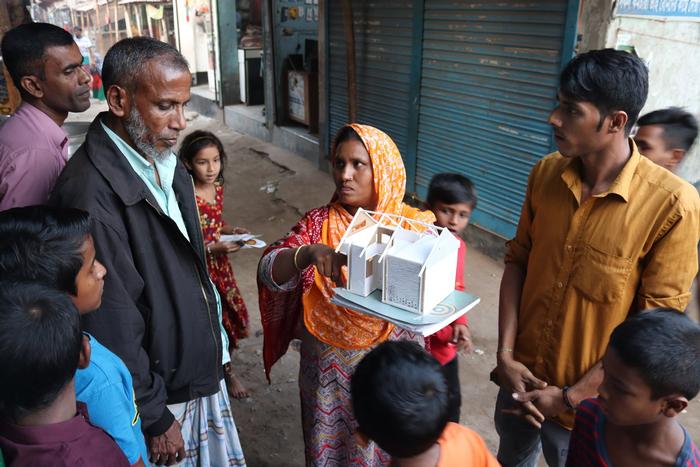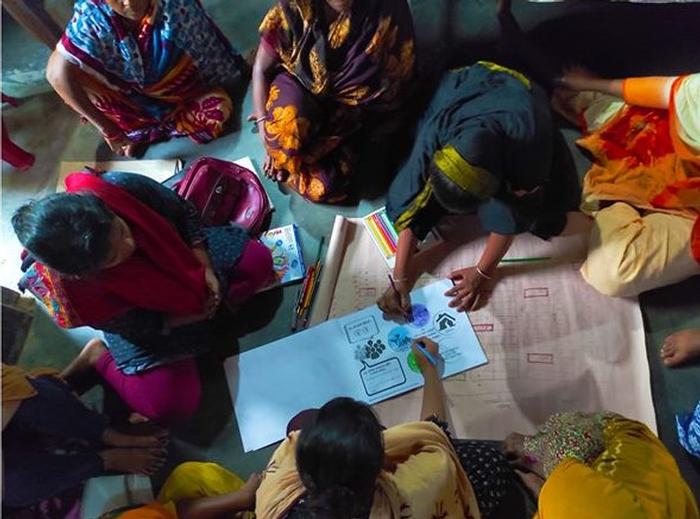Nowshin Matin - ProposalLearning to Co-Learn with POCAAPOCAA (Platform of Community Action and Architects) is a group of people in Bangladesh who aim to facilitate underrepresented and disadvantaged communities to initiate their self-help community development. The professionals and volunteers at POCAA team up with the community to research the available resources and the existing societal system through mapping. Taking this research, POCAA collaborates with other NGOs, practices, and public organizations to develop community-specific strategies. POCAA’s most recent project has been ‘Let’s Co Create Our Community - Dhaka’, which was a part of the ‘Five Model Cities’ project financed by the ACHR-Selavip. The project aimed to support poor settlements by integrating disadvantaged communities with the city’s core housing policy in an attempt to solve urban housing problems. It centered around the Gabtoli Colony. 16 years ago, about 500 families were evicted due to the Hatirjheel Development Project and were relocated to this colony. Now, the colony is home to 1500 families evicted from different parts of the city and it is still growing. At present, two demonstration houses have been built, seeing which, the community decided to build eleven more, which are now under construction. After the first house was constructed the people started calling it ‘Alo Ghor’, which means ‘The lightened house’. POCAA’s involvement with the community was only productive due to the methods adopted during the design process. In my essay, I discovered that when a community finances itself, feelings of ownership instills within the user. POCAA recognizes this strategy and implements it in the project in an innovative way. The organization teamed up with Grambangla NGO and Co-Creation Architects to help members of the community form an association called ‘Shapla Boshoti Unnoyon Shomity’. Members of the association saved 300 BDT (3.48 USD) per month which would contribute to financing the construction of their house. The members then identified the homes in the most vulnerable conditions. These would be the first houses to be reconstructed. Next, the association applied for a home loan after learning about the technicalities of the application process through workshops with POCAA, Grambangla NGO, and Co-Creation Architects. After the procurement of funds, the design phase began. The design was developed with a participatory approach. The outputs and findings generated during this process reflect the relationship of trust and transparency POCAA shares with the community. As I note in my essay, building such a relationship is necessary to establish equilibrium between all stakeholders. When iterating the design with residents, POCAA used 1:50 scale models. However, the scaled models were not sufficient to communicate the design with Khadija Apa, one of the residents. The design team then used chalk to draw on the ground on a 1:1 scale. Designing the participatory method to perfection, which I had previously thought, may not always generate productive outputs. There must be enough room for improvisation. POCAA’s flexibility to improvise made the participatory process successful. The feelings of trust had further encouraged the community to share their aspirations. These added findings gave each house a unique identity. For example, one of the residents, Bilal Bhai, loves birds. Hence, the design of his house had an added bird sanctuary on the first floor. Working collectively also helped the participants realize that the design could not be limited to the house but needed to extend to ameliorate the environment of the colony as well. This realization led the community and design team to brainstorm their aspirations. The output of this would be building vertical garden prototypes with locally found scrap rods and crates. Therefore, the participatory approach led to increasing the scope for design. Finally, when the implementation phase started, the strategies developed during the participatory workshops helped in solving the most challenging part of the process - managing the demolition and construction in the congested alleys of Gabtoli Colony. As all members of the family took part in the construction process, the implementation became easier. In most cases, the residents themselves chose the masons, who would often be from the community. All the houses in the colony may take time to be rebuilt. However, the method in which POCAA worked involved the community in every phase of the project, from securing the loans to building the houses. It has empowered the community with the tools to self-initiate in building the next houses. Capital-driven urban developments have led to thousands of evictions around Dhaka city, forcing families to live in deplorable conditions. Climate migrants from around the country are also forced to settle in congested areas. There are about 5000 such communities like Gabtoli Colony, where material, budget, and space are scarce. Their only strength is in numbers. As a result, community-led processes ensure the efficient use of limited resources. By volunteering with POCAA I will be able to learn the technicalities of these processes. There are a few questions that I hope to explore during my involvement: How are financial modules developed with the community? How are participatory workshops generated? What methods are used to engage participants? How does one identify community needs and aspirations? I hope to investigate the questions above with the community in Beribadh Mohammadpur, where POCAA is working right now. The community is located within Dhaka City, where I currently reside. This community faces the same challenges of high density as the Gabtoli Colony. Most residents here are also victims of evictions around the city. During my 8 week involvement with POCAA, I will primarily be tasked with community profiling. I will also be helping them arrange workshops and assist in conducting them. I will further participate in community meetings and generate daily reflections to be compiled for reports. These activities will give me an insight into how the platform works and collaborates with the community and other organizations to generate strategies. The training that I have received in my architecture school has been more about how I design as an individual, and never how we can design as a community. However, the complexity of issues that Dhaka city faces cannot be dealt with individually, it requires a collaborative approach. I hope the opportunity to volunteer with POCAA will help me broaden my existing architectural knowledge so that I may be able to contribute to the city. Contact: pocaa.bd@gmail.com References: https://pocaa.org/ https://www.facebook.com/pocaabd https://www.iied.org/alada-ghor-working-low-income-communities-design-rapid-response-covid-19
Additional Help and InformationAre you in need of assistance? Please email info@berkeleyprize.org. |




